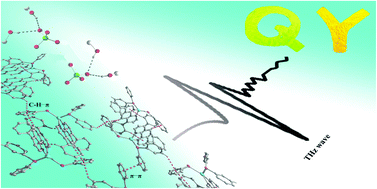Terahertz time-domain absorption spectra of Cu(i) complexes bearing tetraphosphine ligands: the bridge between the C–H⋯π and π⋯π interactions and photoluminescence properties†
Abstract
The synthesis of four heteroleptic dinuclear Cu(I) complexes bearing tetraphosphine and diimine ligands was reported. Complexes 1–3 were successfully obtained through microwave synthesis while complex 4 was synthesized through traditionally stirring at room temperature. These complexes are listed as follows: [Cu2(Dpq)2(dppeda)](ClO4)2·1.5CH2Cl2 (1), [Cu2(neo)2(dppeda)](ClO4)2·1.3CH2Cl2·1.7C4H10O (2), [Cu2(batho)2(dppeda)](ClO4)2·C4H10O (3), and [Cu2(batho)2(dpppda)](ClO4)2·3CH2Cl2 (4) {(Dpq = pyrazino[2,3-f][1,10]phenanthroline, batho = 4,7-diphenyl-1,10-phenanthroline, neo = 2,9-dimethyl-1,10-phenanthroline, dppeda = N1,N1,N2,N2-tetrakis[(diphenylphosphino)methyl]-1,2-ethanediamine, and dpppda = N1,N1,N4,N4-tetrakis[(diphenylphosphino)methyl]-1,4-benzenediamine}. Their crystal structures have been elucidated by X-ray crystallography and their photophysical properties have been investigated in detail. Photophysical studies and time domain density functional theory (TD-DFT) calculations show that the luminescence performance of these four complexes is ascribed to metal-to-ligand charge transfer (MLCT) mixed with ligand-to-ligand charge transfer (LLCT), and complex 2 shows green emission at 574 nm with the highest quantum yield of up to 52.80%. In addition, the research of photoluminescence properties under the guidance of terahertz spectroscopy technology leads to the preliminary discovery of a correlation between crystal packing and luminescence. It is found that the terahertz spectrum and absorption peak are strongly interdependent on C–H⋯π and π⋯π interactions, and the external weak interactions have negative effects on the luminescence performance. Herein, we predict that the terahertz spectroscopy analysis establishes a bridge between weak interactions (C–H⋯π and π⋯π interactions) and the photoluminescence properties, and puts forward a problem that should be noticed in designing Cu(I) complexes.



 Please wait while we load your content...
Please wait while we load your content...